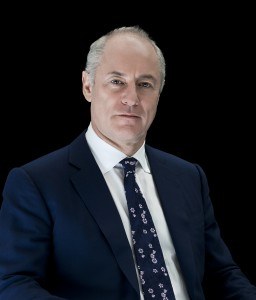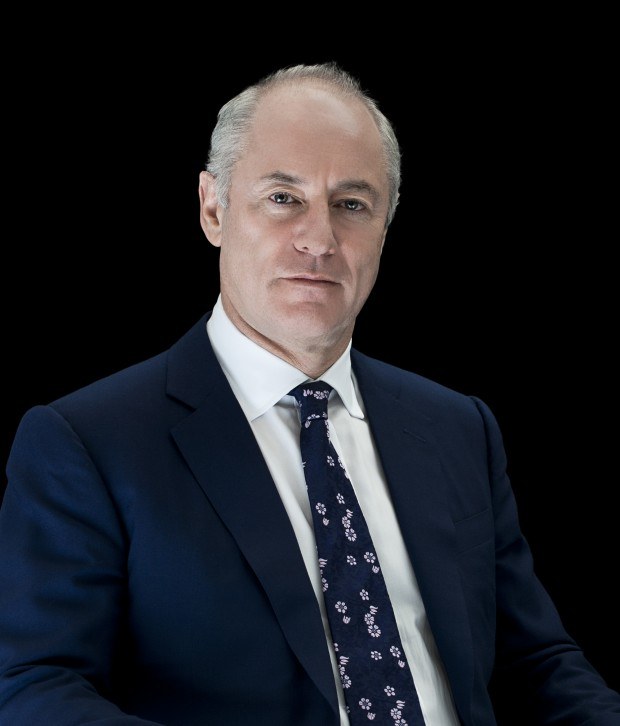The chief executive of Aspen Insurance Holdings Limited described business changes to Aspen’s Lloyd’s insurance book last week, while neither unequivocally confirming or denying rumors that a deal to sell the entire company is imminent.

“In areas like property treaty or offshore energy, we’ve seen some good people go. I’ve been sorry to see them go. I think they remain friends of Aspen. I like to think some of them remain friends of mine.”
Chris O’Kane, Aspen Insurance Holdings
Focusing on operating income of $56.3 million for the second quarter, rather than a bottom-line net loss of $14.7 million that was complicated by the noise of investment and foreign exchange losses, O’Kane said the operating result was testament to a “tremendous amount of work being done at Aspen” to enhance both financial and operational performance.
Concluding his prepared remarks, O’Kane said, “Our board, our leadership team and our employees right across the company are enthusiastically committed to delivering strong results and creating shareholder value.” He continued by repeating a message he delivered on the first-quarter earnings call. “Our board is very open minded. All options remain on the table [for] preserving and creating shareholder value,” he said. “Those statements have always been true, are still true and very much on the forefront of our minds,” he said, committing to inform shareholders and analysts “when a material change occurs.”
In spite of the fact that O’Kane said he would not comment on those matters any further during the call, the first analyst to pose a question, perhaps motivated by the amount of time O’Kane devoted to detailing line-by-line hits and misses and improvement plans, asked whether the board might envision the possibility of a standalone Aspen continuing to exist.
O’Kane reiterated his prior statement. “The board is open minded. It should be open minded and what we are evaluating is what is the best course of action for our shareholders in creating and preserving value. What our particular course is ranging from a sale to continuing independent [among options] is an open question.
“I can’t rule in or rule out anything,” he said.
“We’re still looking at that. It won’t take forever,” he said, promising to address the issue again “relatively soon.”
How soon? the analyst pressed.
“I think I’ve been purposely vague. I’m not going to help you any further with it,” O’Kane replied.
What’s In, What’s Out
O’Kane was more direct about targeted lines of business for Aspen and lines that are set to be discontinued at Lloyd’s.
While net written premium fell 16 percent to $486.0 million in the second quarter, the CEO noted an 8.5 percent jump in gross premiums for the insurance book to $527.8 million, and highlighted 15 percent growth in gross premiums and an accident year loss ratio of 55 for targeted lines of accident and health, excess casualty, environmental, professional and related lines. (Net premiums declined primarily from the use of quota share reinsurance, the company said in a media statement.)
Also noting signs of improvement in Aspen’s U.S. property and onshore energy books after some earlier remedial actions, O’Kane turned his attention to the Lloyd’s insurance book, which he said represents over one-quarter of insurance segment premium. “This part of our business has a five-year average loss ratio of 62—the same as the second quarter. This is good but we need it to be better.”
To make it better, Aspen will grow the best performing business lines but will no longer underwrite disappointing areas—”specifically, international, professional indemnity, marine hull.” Later in the call, O’Kane also specifically noted that aviation at Lloyd’s is on the chopping block. But the company will allocate more capital to “extremely valuable” lines like cyber, transaction liability, financial institutions and management liability, as well as some broader marine lines. (See related article, “Underwriting Pain, Exits Begin; Insurers Rethinking Lloyd’s“)
At several points during the call, O’Kane called out professional and related liability lines as a growth area for the company—in the U.S. and internationally. He specifically noted the track record of leader Bruce Eisler in the United States, where growth is roughly 14 percent annually and the combined ratio has been around 80 for the last five years.
Aspen also writes reinsurance, which had single-digit declines in gross and net premiums in the quarter. In reinsurance, O’Kane noted that the underwriting team has been disciplined, making adjustments where the market is uncooperative—for example, in areas of specialty reinsurance like trade credit where underlying business is good but ceding commissions are just too high. At one point during the call, he also explained why Aspen’s reinsurance book had not suffered from unfavorable developments related to Hurricane Irma that other reinsurers experienced. (See related article, “Tale of Two Floridas: Hurricane Irma’s Belated Impact on Reinsurers“)
Meaningful Workforce Reduction Ahead
While it remained unclear whether the second-quarter earnings call might be O’Kane’s last in the role of CEO of a standalone Aspen, analysts repeatedly asked about the impact of market rumors on the workforce. O’Kane provided his reflections, also revealing that outsourcing of some functions could have a greater impact next year.
Responding to an analyst who asked O’Kane to compare the current employee count to a figure of 1,300 that he read in Aspen’s 2017 10-K filing, the CEO said it is roughly the same today. “Clearly in most cases, when people leave in an unplanned way, you go and replace them. Given the cost-conscious environment, I sign off on every new employee, and I’ve got to say I’m a bit busier than I would like to be in that regard,” O’Kane reported. “Maybe a week goes by, but never two weeks that there isn’t 10-15 people,” he said. (O’Kane also noted that Aspen had 200-300 more employees in 2016 when it sold a crop insurance business, AgriLogic, as year-end 2017.)
While the headcount is stable now, O’Kane said “a gradual program of making ourselves more efficient—getting more done with fewer people in the organization and outsourcing more functions” will have an impact on the workforce numbers going forward. “That hasn’t really begun to bite yet. We’re just at the beginning really in the last few weeks. Going forward, you would find a meaningful reduction to that 1,300—if we’re talking this time next year, something in the range of 10-20 percent would not be inconceivable,” O’Kane estimated.
Addressing questions about unplanned departures, O’Kane said that while some key people had left, he’s not concerned about the company’s ability to meet the needs of clients and brokers in any lines of business. “There’s nothing that makes me uncomfortable,” he said.
O’Kane began his remarks on this topic by describing a planned workforce “streamlining” or “efficiency program” last year.
Those are “the polite words for saying that when [you’ve got] too many senior people doing similar jobs, then you can take some of them out, have a longer span of control and take out some expensive head count. And we did some of that,” he said. “So, some good people left.”
He also noted that each individual underwriting team “had a sort of mini-operational hub within it.” So, in the name of efficiency, Aspen is not leaning to building bigger hubs.
Moving from targeted reductions to other situations—like instances “where people say, ‘Well, you might have moved my job on, so I’m going to move myself,” O’Kane admitted, “We have had some of that.”
“Mostly, we identified the people that we regarded as valuable, we maybe put some retention payments around that, and I think we’ve limited that damage to the extent it could be limited.”
It can’t always be, however.
“There’s another set of factors from the news feed that we have had in the last few months,” he said, referring to the fact that competitors have started calling some of Aspen’s underwriters and actuaries to entice them to jump ship as rumors of a potential sale heated up. “I don’t blame them at all for this,” he said of the competition. “And whereas a year or so ago, [targeted employees] would have said, ‘No, I’m very happy at Aspen,’ they now would say, ‘I’m very happy at Aspen but.’ We have had a few of those.”
Still, O’Kane said, “There isn’t a single situation where I think we lack the underwriting ability to be a serious and effective player in what we do.”
He continued: “In areas like property treaty or offshore energy, we’ve seen some good people go. I’ve been sorry to see them go. I think they remain friends of Aspen. I like to think some of them remain friends of mine,” he said.
Thoughtful succession planning has helped, he suggested, noting the strength and depth to promote from within, leaving only one or two situations where new underwriter replacements needed to be hired.
“If you look at an increase in attrition rates among key people, it’s up a little bit year on year. And if you sort of laser focus within that, you’re down to a handful—five or six people [where I have thought] I really wish they were still here,” O’Kane said.
Addressing the analyst’s concern head on, he explained that workforce changes haven’t impacted business. “As of this morning, I can tell you that every single reinsurance client that we started this year with is still a reinsurance client. And on the insurance side, we have a growth rate actually better than we’ve had for a couple of years. We reduced our growth rate two years ago because we wanted to reposition the book, and insurance had been down. We’ve now got a lot of good people doing a lot of good work, and we’re doing a lot more business.”
“If you look at the hard numbers, it looks pretty good. Overall, I’d give us an A+ but maybe not an A++,” he said.





















 First Atlantic Hurricane Forecast for 2026 Suggests Season Close to 30-Year Norm
First Atlantic Hurricane Forecast for 2026 Suggests Season Close to 30-Year Norm  Carrier Management’s 2025 Top Features (Reader’s Picks Unlocked)
Carrier Management’s 2025 Top Features (Reader’s Picks Unlocked)  What to Expect in 2026: U.S. P/C Results More Like 2024
What to Expect in 2026: U.S. P/C Results More Like 2024  Underwriter, Actuary Fears of AI Drop; Work Needed on Collaboration
Underwriter, Actuary Fears of AI Drop; Work Needed on Collaboration 















